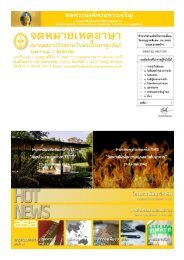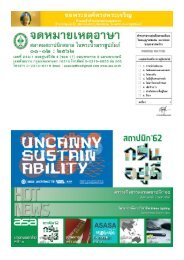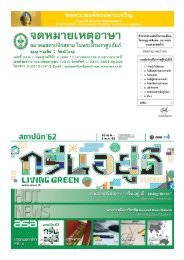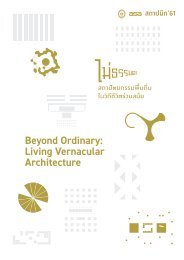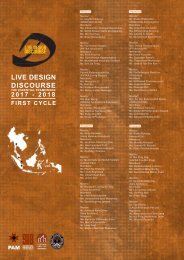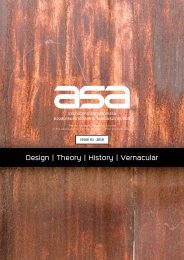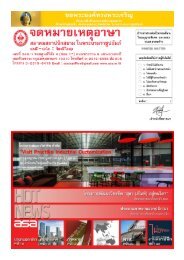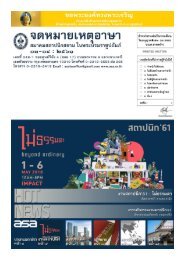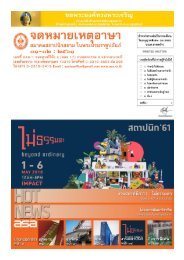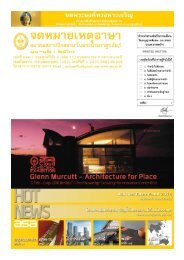ASA JOURNAL Vol.2 | 2018
You also want an ePaper? Increase the reach of your titles
YUMPU automatically turns print PDFs into web optimized ePapers that Google loves.
outique accommodations also had a category on the topic of<br />
Renovation & Modification in addition to other themes.<br />
Likewise, international architectural design awards such as<br />
AR New into Old awards by the Architectural Review magazine<br />
particularly addresses creative adaptive reuse projects. It is<br />
also notable that social media today plays a part in increasing<br />
familiarity of adaptive reuse of old buildings for the public.<br />
Online articles via web board, web logs or Facebook posts to<br />
review building renovation projects concerning both physical<br />
characteristics and renewed functions promote such<br />
practices, while encouraging the public to see the potential of<br />
previously-occupied buildings and their benefits in terms of<br />
investment, function and conservation of their history and<br />
values.<br />
Conclusion: from the Past to the Future of<br />
Adaptive Reuse<br />
Adaptive Reuse or Adaptive Use is a process of returning<br />
to the active use of an old building in an approach other<br />
than that for which it was designed for and requiring varying<br />
levels of physical modification to the building. It is considered<br />
a useful way to return to the active life to an old structure, be<br />
it a historic artifact or a previously-occupied contemporary<br />
building, to achieve its functional potential, promote and<br />
protect its integrative values in terms of history, art, architecture,<br />
culture, economy and resources. Adaptive reuse projects in<br />
Thailand are developed to achieve varying causes and objectives,<br />
from being a tool to safeguarding cultural heritage and as an<br />
approach to utilize existing structures. Such implementations<br />
are considered more convenient and economical in many<br />
cases when compared to constructing a new building, while<br />
the process also generates income to at least partly cover the<br />
structure’s restoration and maintenance costs. Building conversion<br />
in the past can be found in the tradition of donating<br />
old Thai houses to Buddhist temples or to dismantle and<br />
reassemble it in another location. A number of vacant palaces<br />
and noble residences have been converted into governmental<br />
or institutional offices when there were no longer in use.<br />
Adaptive reuse in the past as a conservation approach usually<br />
concerned architectural hierarchy related to social ranking,<br />
history and original uses, resulted in rather conservative<br />
adaptations of the historical artifacts into museums and<br />
governmental offices. As conservation methods and modern<br />
ways of life have become increasingly more open for interpretations,<br />
we have seen more adaptive reuse case studies for<br />
public and commercial uses, many of which are operated by<br />
private sectors, for example, retail, restaurants, tourist accommodations<br />
and small businesses. Many projects were developed<br />
as a result of economic and social conditions. Recently, the<br />
practice of adaptive reuse shows a wider variation, especially<br />
its application on industrial structures such as underused<br />
factories and warehouses, to support activities fitting with<br />
lifestyles and tastes of today’s generations. Regardless of<br />
principal objectives and reasons of building adaptations either<br />
to hide failures or to preserve cultural heritage and glory of<br />
the past, it is undeniably an interesting and efficient solution<br />
to address and respond to changing needs. Functional conversion<br />
has been considered a challenging condition for both<br />
proprietors and architects to develop the project and propose<br />
appropriate designs in order to protect values and present<br />
potentials of the architecture, while carefully retaining a good<br />
balance between conservation and development. qualities,<br />
including planning, structure and related building<br />
เอกสารอ้างอิง / Bibliography<br />
กรมศิลปากร กระทรวงวัฒนธรรม. (2547). โครงการวิจัยเรื่องการจัดการด้านการออกแบบพิพิธภัณฑสถานแห่งชาติ. กรุงเทพฯ: บริษัท<br />
รุ่งศิลป์การพิมพ์ (1977) จำากัด.<br />
ปิ่นรัษฎ์ กาญจนัษฐิติ. (2552). การอนุรักษ์มรดกสถาปัตยกรรมและชุมชน. กรุงเทพฯ: โรงพิมพ์แห่งจุฬาลงกรณ์มหาวิทยาลัย.<br />
ผุสดี ทิพทัส และคณะ. (2553). สถาปัตยกรรมหลัง พ.ศ. 2540: วิกฤตการณ์และทางเลือกของสถาปนิกไทย. กรุงเทพฯ: สมาคม<br />
สถาปนิกสยามในพระบรมราชูปถัมภ์.<br />
ภูวดล สุวรรณดี. (2539). “เก็บอาคารเก่าเข้าสุสาน บทพิสูจน์รสนิยมใหม่กับคุณค่ามรดกไทย.” ศิลปวัฒนธรรม. ปีที่ 17(3) มกราคม:<br />
หน้า 85-90.<br />
Charles Bloszies. (2012). Old Buildings, New Designs: Architectural Transformation. New York: Princeton Architectural<br />
Press.<br />
James Marston Fitch. (1995). Historic Preservation: Curatorial Management of the Built World. Charlottesville: University<br />
Press of Virginia.<br />
Saithiwa Ramasoot. (2008). Dismantle, Reassemble, and Modify: An Adaptive Reuse of the Traditional Thai House.<br />
Ph.D. Dissertation. University of Pennsylvania.<br />
Saithiwa Ramasoot. (2014). Tradition as Represented in Tourism: Adaptive Reuse of Old Houses as Boutique Hotels in<br />
Bangkok. Traditional Dwellings and Settlements Working Paper Series. Vol. 269.<br />
William J. Murtagh. (1997). Keeping Time: The History and Theory of Preservation in America. New York: John Wiley<br />
& Sons, Inc.<br />
98 99<br />
วารสารสถาปัตยกรรมของสมาคมสถาปนิกสยาม<br />
ในพระบรมราชูปถัมภ์ Issue 02 / <strong>2018</strong><br />
Academic Journal of The Association of Siamese Architects<br />
under the Royal Patronage<br />
วารสารสถาปัตยกรรมของสมาคมสถาปนิกสยาม<br />
ในพระบรมราชูปถัมภ์ Issue 02 / <strong>2018</strong><br />
Academic Journal of The Association of Siamese Architects<br />
under the Royal Patronage




